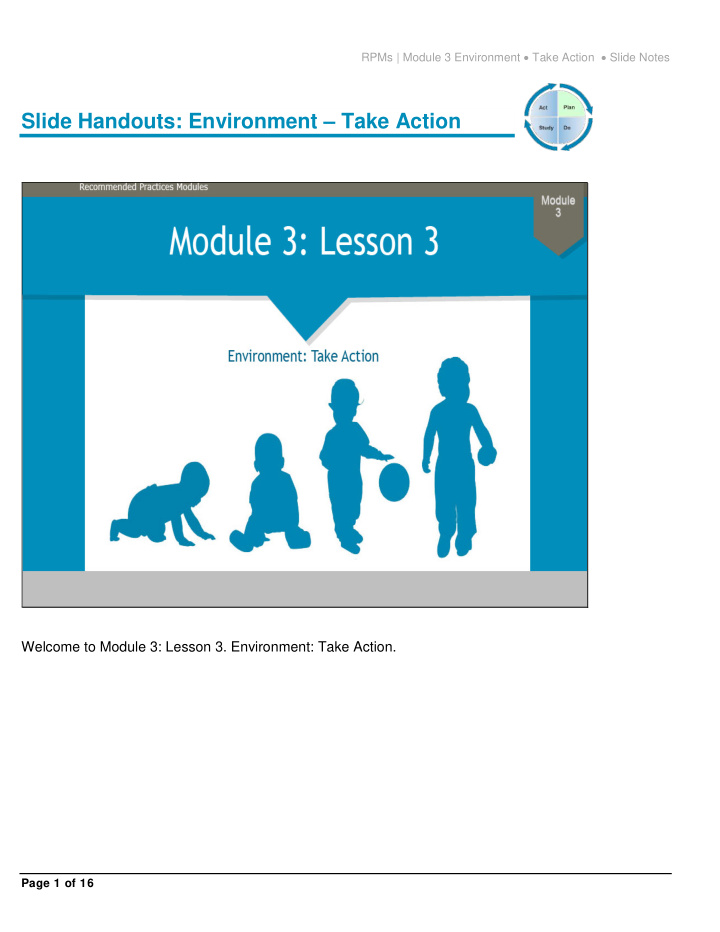



RPMs | Module 3 Environment • Take Action • Slide Notes Slide Handouts: Environment – Take Action Welcome to Module 3: Lesson 3. Environment: Take Action. Page 1 of 16
RPMs | Module 3 Environment • Take Action • Slide Notes In this lesson, you will understand how to observe the child's level of participation in an activity and identify how it could be increased. You will also learn how to modify or adapt the environment, and how to use assistive technology to support child learning. Page 2 of 16
RPMs | Module 3 Environment • Take Action • Slide Notes The 2014 DEC Recommended Practices have recommended the following practices to support environment. You may download a list of the practices by clicking the download button. The document will open in a new window. Continue when you have finished your review. Page 3 of 16
RPMs | Module 3 Environment • Take Action • Slide Notes Before modifying a child's environment, think about the following key considerations. Review each, then press continue. Page 4 of 16
RPMs | Module 3 Environment • Take Action • Slide Notes Watch the following video and think about ways to adapt or modify physical space so all children may participate fully in the environment. You may want to watch it a few times and make some notes. Click on the play button to watch the video. When you are ready to move on, click Continue. Page 5 of 16
RPMs | Module 3 Environment • Take Action • Slide Notes Now that you have had a chance to practice identifying ways to adapt and modify physical space, let's take a look at some more examples. On each of the following examples, listen for and review the prompts. Watch the video using the play button, then press continue to move forward. You may recognize some of the modifications you came up with as well as some ideas you hadn't considered. Page 6 of 16
RPMs | Module 3 Environment • Take Action • Slide Notes Now let's practice observing the child to identify their level of participation in the environment. Page 7 of 16
RPMs | Module 3 Environment • Take Action • Slide Notes In this example, you will see that the mother has provided an adaptation by moving a chair next to the sink, so the child is able to reach the sink. Look for and write down how the child participates in the activity. Page 8 of 16
RPMs | Module 3 Environment • Take Action • Slide Notes You may have noticed the child participating by scooping and pouring water from the cup, asking her mother questions about the items in the water, and engaging in back and forth conversation with her mother. Page 9 of 16
RPMs | Module 3 Environment • Take Action • Slide Notes In this next video clip, we observe a child who is blind. His teacher has observed that the child’s level of participation during shared story book reading is low. In response to the low participation, his teacher has decided to create a book that allows the child to touch and move parts of the book. Look for and write down how the child participates in the activity of shared story book reading. Page 10 of 16
RPMs | Module 3 Environment • Take Action • Slide Notes During your observation you may have noticed that the child is participating in the activity by counting beads; engaging in joint interaction by counting the number of beads and verbally responding to the teacher when asked how many beads; and how the child physically moves the beads while he counts each of them. Page 11 of 16
RPMs | Module 3 Environment • Take Action • Slide Notes In this video, try to identify the following: How is the child involved in the activity? How might she be more involved? Can you identify an adaptation that might support her involvement? Page 12 of 16
RPMs | Module 3 Environment • Take Action • Slide Notes Here are possible adaptations you may have considered to increase the child’s participation in the activity of watering the flowers. Read over the list, then click continue to move forward. Page 13 of 16
RPMs | Module 3 Environment • Take Action • Slide Notes In this lesson, we learned how to observe the child's level of participation in an activity and identify how it could be increased. We also reviewed how and when to modify or adapt the environment, including physical space, temporal-everyday activities and routines, and materials in order to optimize child learning in different environments. Page 14 of 16
RPMs | Module 3 Environment • Take Action • Slide Notes Are you ready to check your knowledge? You will be presented with three vignettes and a selection of adaptations and modifications to choose from. Select the two adaptations or modifications that would benefit each child most. Page 15 of 16
RPMs | Module 3 Environment • Take Action • Slide Notes This concludes Module 3, Lesson 3. Thank you for participating. To learn more, see the resources listed. After downloading, you can close this window. Page 16 of 16
Recommend
More recommend